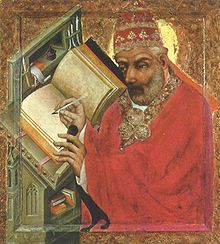- Theodoric of Prague
-
Theodoric of Prague 
Gregory the Great from the Chapel of the Holy CrossBorn 1360 Died 1380 Theodoric of Prague or Master Theoderic (in Latin Magister Theodoricus (working ca. 1360–1380) was a Gothic painter who was court painter to Charles IV, Holy Roman Emperor and the first Bohemian painter whose name can be linked to a body of work. His masterpiece, by which he is known, is the Chapel of the Holy Cross at Charles' newly-completed Karlštejn Castle castle-palace near Prague, containing a large series of slightly over-lifesize half-length panel portraits of saints and other notable figures on a gold ground, commissioned in 1359, though completed over a number of years. Theodoric was the first Czech painter whose works are confirmed by archived documentation.
Theodoric’s magnum opus is a collection of panel paintings and wall paintings that were done on the commission of Charles IV for the Chapel of the Holy Cross at Karlstejn Castle. All together, there are 129 works, all of saints, prophets, or angels. The National Gallery in Prague said that they “only few equals in the world: we believe that it is no exaggeration to say that they bear comparison with such artistic monuments and phenomena as the Arena in Padua, the churches at Assisi or Sta, Croce in Florence [and the] palace of the popes in Avignon.”[1]
Known for his bold and vigorous style, he is seen as a central figure in the development of Bohemian art. As many other Gothic painters, he used very bright and attention-grabbing colors and bold lines. He painted powerful figures in small frames, filling the viewer with the notion of monumentality. Famous for his use of light and reflection, he created the illusion of endless space in his work by allowing light to travel beyond the frame. He is considered a pioneer in this area. Scholars have disagreed on several aspects of Theodoric’s career. One historian noted that Theodoric was a “unique phenomenon”[2] whose works could not be explained by stylistic evolution, as there were no precedents for his art work, making one believe that he may have been self taught. Another scholar held an opposite opinion—that he was influenced both by Italian and French contemporary art.
Theodoric died c. 1381.[citation needed]
Links
- ^ "Magister Theodoricus, court painter of Emperor Charles IV" by Jiri Fajt & Jan Royt, published by the National Gallery in Prague in 1997 ISBN 80-7035-161-6
- ^ Gothic Painting
See also
Categories:- Czech painters
- Gothic painters
- 14th-century people
- Court painters
Wikimedia Foundation. 2010.
